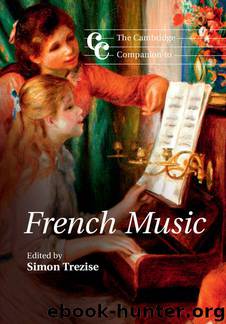The Cambridge Companion to French Music (Cambridge Companions to Music) by Simon Trezise

Author:Simon Trezise [Trezise, Simon]
Language: eng
Format: epub
Publisher: Cambridge University Press
Published: 2015-02-28T03:00:00+00:00
Waiting for Rameau
After Lully’s death, the tragédie en musique inevitably went through stylistic changes. The Italianism of Médée (1693) by Marc-Antoine Charpentier (1643–1704) was seen as a threat by the Lullistes, who identified the work with the typical excesses of transalpine music.22 Chromaticism and dissonance are more frequent in Médée than in any of Lully’s operas, and the vocal lines of its récits often break into brief arioso sections. Early eighteenth-century tragédie en musique is also characterised by an increase in the number of short airs within large recitative sections composed in the declamatory style of the récit non mesuré.23 Vocal technique grew with the appearance of ariettes, which arose from the influence of Italian vocal and instrumental music and cantata in France. The term ariette could be applied to a song following the binary AABB form or to the Italian da capo aria model. Ariettes are to be found in Campra’s Les fêtes vénitiennes, a work hugely popular and frequently performed up to the mid-eighteenth century.
The generous display of dances in opéra-ballet was echoed in tragédies en musique. Also prominent were symphonies descriptives, with a predilection for the description of natural phenomena, including sommeils (‘slumbers’; an early example by Lully is in Atys, Act III, scene 4) and earthquakes.24 The new generation of composers (Collasse, Campra and Marin Marais, 1656–1728) developed the role of the orchestra with a refined use of instrumental colour. Despite its modest size and relative simplicity, the instrumental tempest in Act III, scene 4, of Marais’s tragédie Alcyone (1706) was the most frequently cited example of symphonies descriptives throughout the eighteenth century. Other examples include the earthquake in Marais’s tragédie Sémélé (1709) and an earthquake with chorus in Campra’s Tancrède (1702). The most impressive earthquake belongs to an opéra-ballet by Rameau, ‘Les Incas du Pérou’ from Les Indes galantes (1735); because of its difficult instrumental writing, the earthquake was left out of the first performances. As for the ariette, it also made its way into the tragédie en musique. Instrumentation echoed Italian cantatas and instrumental music: the ariette ‘Amour, régnez en paix’ from Marais’s Sémélé (Act III, scene 4) requires two obbligato flutes.
‘My Lord, there is enough music in this opera to make ten of them’, was the purported bon mot from Campra about Hippolyte et Aricie (1733), Rameau’s first tragédie en musique.25 Indeed, with this work Rameau efficiently absorbed contemporary trends and opened a new chapter in the history of French opera. It also sparked off the Querelle des Lullistes et des Ramistes, the famous eighteenth-century debate that perpetuated the Querelle des anciens et des modernes. Denis Diderot’s libertine novel Les bijoux indiscrets, set in the kingdom of Banza (a mocking allegory of France), offered a spirited account in 1748 featuring ‘Utmiutsol’ and ‘Uremifasolasiututut’ as Banza’s most famous musicians, ‘the former starting to grow old’ and the ‘latter just born’; ‘the ignorant and the old fogeys’ favoured Utmiutsol, ‘the young and the virtuosos’ favoured Uremifasolasiututut, and ‘the gens de goût, whether young or old, mostly supported both of them’.
Download
This site does not store any files on its server. We only index and link to content provided by other sites. Please contact the content providers to delete copyright contents if any and email us, we'll remove relevant links or contents immediately.
Aircraft Design of WWII: A Sketchbook by Lockheed Aircraft Corporation(32140)
The Great Music City by Andrea Baker(30801)
Call Me by Your Name by André Aciman(19934)
The Art of Boudoir Photography: How to Create Stunning Photographs of Women by Christa Meola(18414)
The Secret History by Donna Tartt(18227)
Shoot Sexy by Ryan Armbrust(17564)
Plagued by Fire by Paul Hendrickson(17119)
Portrait Mastery in Black & White: Learn the Signature Style of a Legendary Photographer by Tim Kelly(16877)
Adobe Camera Raw For Digital Photographers Only by Rob Sheppard(16805)
Photographically Speaking: A Deeper Look at Creating Stronger Images (Eva Spring's Library) by David duChemin(16505)
Ready Player One by Cline Ernest(14033)
Pimp by Iceberg Slim(13807)
Bombshells: Glamour Girls of a Lifetime by Sullivan Steve(13703)
The Goal (Off-Campus #4) by Elle Kennedy(13210)
Art Nude Photography Explained: How to Photograph and Understand Great Art Nude Images by Simon Walden(12858)
Kathy Andrews Collection by Kathy Andrews(11343)
The Priory of the Orange Tree by Samantha Shannon(8638)
Thirteen Reasons Why by Jay Asher(8472)
The remains of the day by Kazuo Ishiguro(8418)
